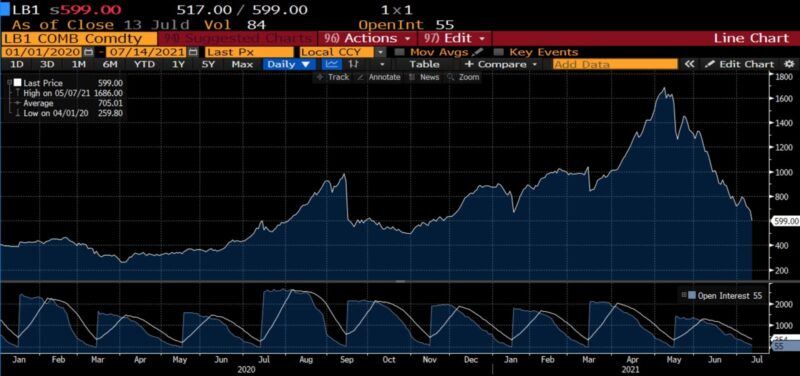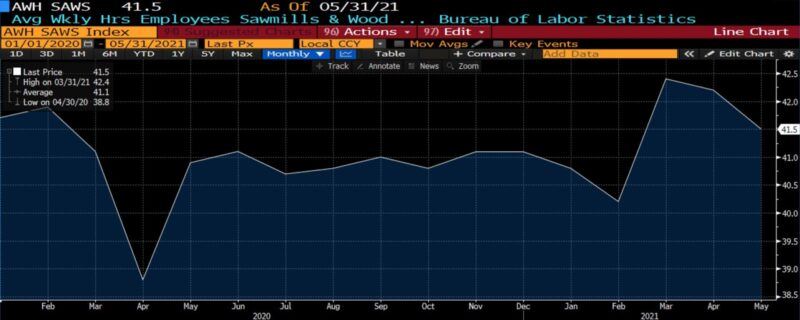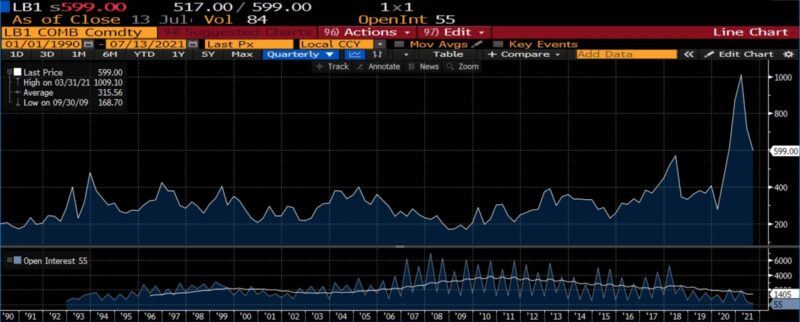Lumber Prices Return to Earth

After a record price spike which took it from a low of $259 (per thousand board-feet) in April 2020 to an all-time high of $1,686 on 7 May 2021 ($1,733 intraday), lumber futures closed at $599 yesterday. That price is still almost twice the average going back to January 2010, but the first closing price below $600 since mid-November 2020. After quadrupling in a thirteen-month period, lumber futures prices dropped 40% in June.
Lumber prices per thousand board-feet (2020 – present)

In March and April of 2020, mills and timber operations closed in accordance with shutdown orders. Shortly thereafter demand for wood and wood products exploded amid a DIY craze and a homebuilding surge, all of which were intensified by hundreds of billions of dollars in government stimulus payments. The lumber market’s reputation as a languid affair where only the savviest hedgers and producers venture is no more; at one point the demand for trading was so fervid that the FTX cryptocurrency exchange opened an electronic lumber futures market.
What accounts for the sudden reinstatement of gravity? According to several sources, nothing more sophisticated than rapidly increasing lumber inventories at wholesalers and retailers as home improvement projects are completed and amateur carpenters return to work en masse. High prices signal scarcity, and producers seek to take advantage of higher prices and typically higher-than-average profits therein. Since February, for example, the US Bureau of Labor Statistics has reported a rise in the average weekly hours worked at sawmills and related businesses.
Average weekly hours, US sawmill employees (Jan 2020 – present)

More supply, decreasing demand, lower prices: that the price system works should come as little surprise. A question better worth considering is how quickly lumber prices might have come back to historic price levels–or how much lower the highest price may have been–without such hindrances as the Biden Department of Commerce’s refusal to remove the Trump Administration’s tariffs on lumber from Canada. (Not only has the Biden Administration not removed them, but plan to essentially double those assessments later in 2021.)
There is uncertainty ahead, as always. Sometimes when the run-up in a commodity’s price is reflective of large changes in its provision or use, new ranges and levels of volatility prevail. And there is no guarantee, especially with such complications as the spread of the Covid-19 “delta variant” and several nations now oscillating regularly between lockdowns and openings, that another burst to record levels isn’t in the cards. But as with most commodities, lumber exhibits seasonal patterns reflective of forestry and construction activities; the price tends to fall in the early summer, perk up in September, and then fall throughout Autumn. Part of this decline, which began in mid-May, is likely reflective of those influences as well.
Lumber prices per thousand board-feet (1990–Present)

It is precisely this type of market action which central bankers and inflation doves are pointing to as evidence that rising prices are “bottlenecks”–temporary distortions associated with highly disjointed supply and demand–as opposed to inflation. Yet there are signs in financial markets and asset prices strongly suggesting the return of inflationary pressures. A new round of expansionary monetary policy, wildfires, or other developments could bring more upheaval to this ordinarily sedate market, but for now it appears that the lumber market delirium has been quelled.









